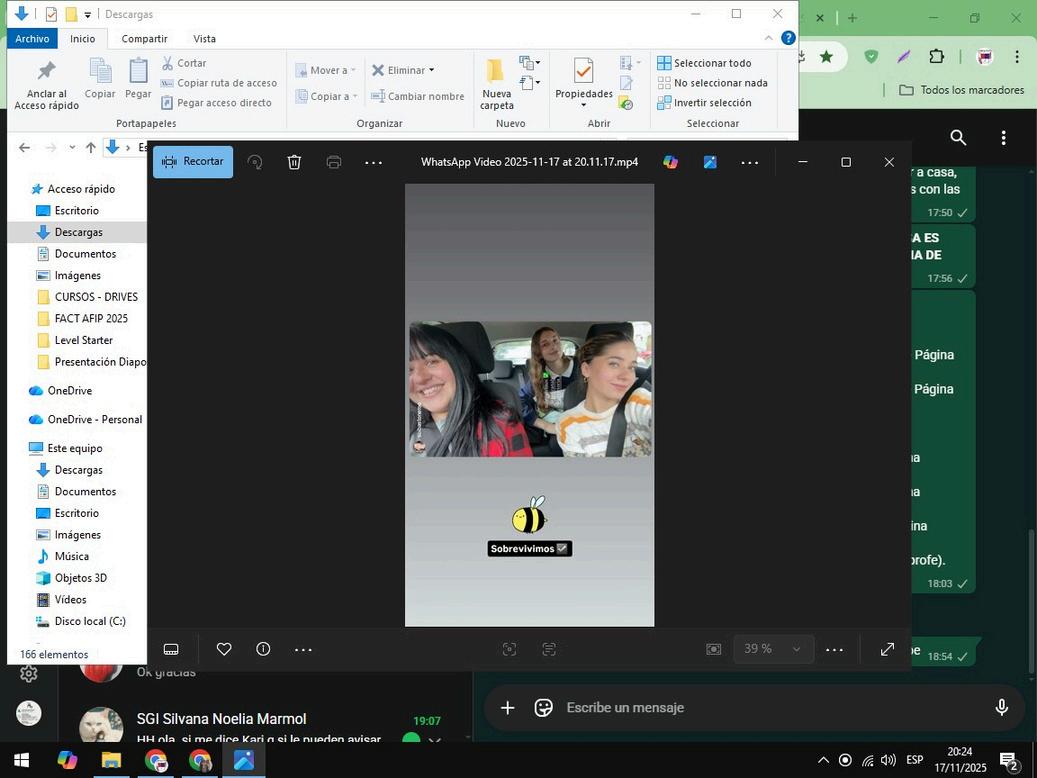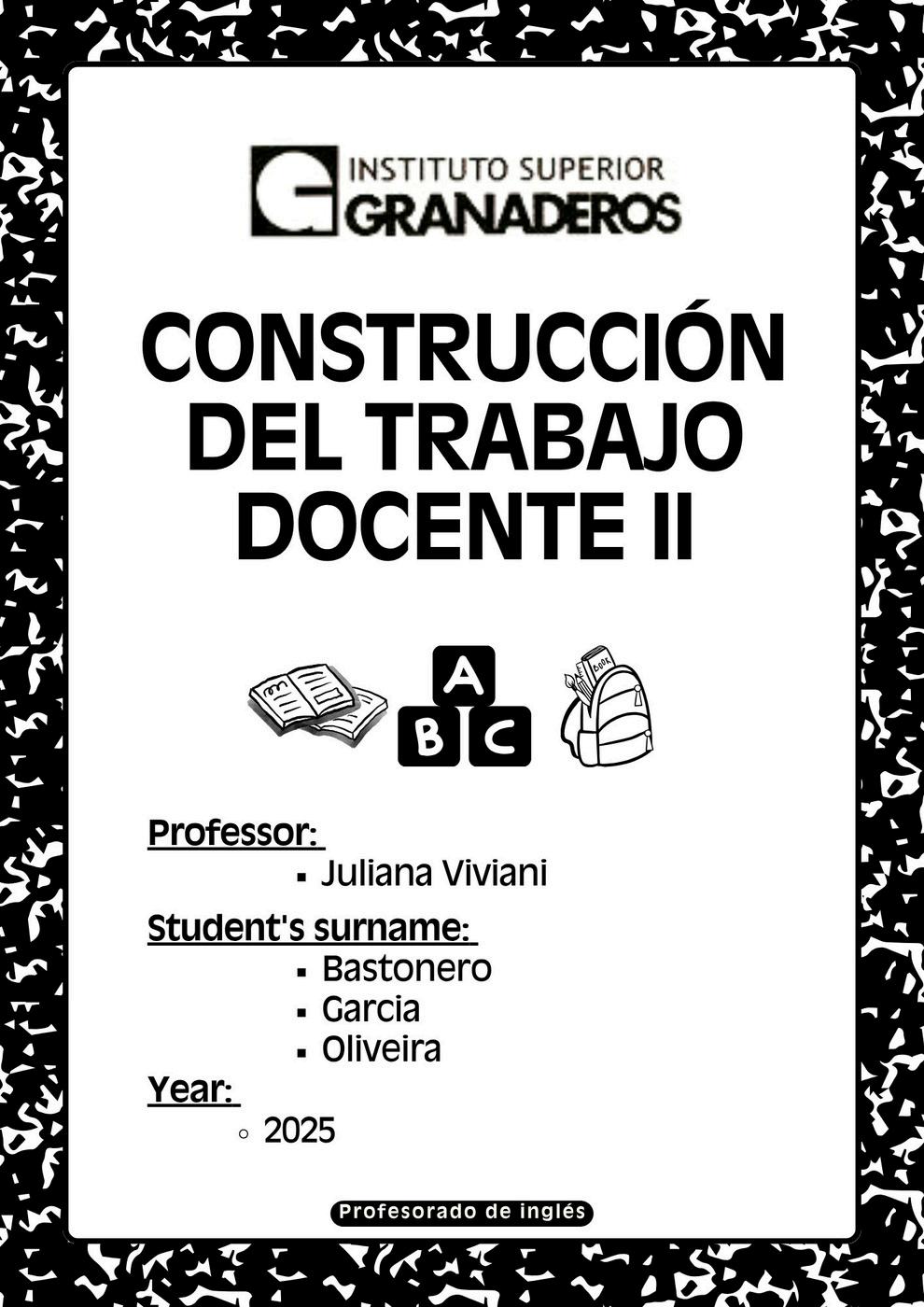



● El reglamento de prácticas correspondiente al presente ciclo lectivo fue leído atentamente, firmado y entregado en formato impreso a la docente responsable, cumpliendo con los plazos y requisitos establecidos por la institución


BASTONERO

GARCIA




OLIVEIRA





























Grade 90.00 / 100.00
Graded on Tuesday, 13 May 2025, 2:44 PM
Graded by JVJuliana Viviani
Feedback comments:
Dear students,Seevidenciaunanálisis profundo y articulado de la normativa vigente, así como un compromisoconlaconstrucción de una convivencia escolar democrática y respetuosa. El Acuerdo Escolar de Convivencia que elaboraron está claramente fundamentado, con un lenguaje accesible y preciso. Destaco especialmente:La inclusión clara de losprincipiosrectores,queguían tanto las normas como los procedimientos para la resolución de conflictos.
El abordajedelconflictodesdeuna perspectiva educativa, preventiva y restaurativa, en consonancia con la Resolución 1724/11.
La redaccióndelosderechosyresponsabilidades de los distintos actores institucionales está muy bienorganizadayescoherente con los marcos legales citados.
El tono deldocumentopromueveuna mirada formativa, democrática y participativa, lo cual es sumamentevaliosoencontextosescolares actuales.
En cuantoalContratoDidáctico,también valoro positivamente la estructuración clara de los compromisos y el enfoque en el aprendizaje activo. Se destaca:
La coherenciaconlanormativa,incluyendo menciones pertinentes a la Ley 26.206 y a la Ley 13.688.
La especificación de objetivos de aprendizaje, estrategias de evaluación y recursos disponibles.
El uso de un lenguaje profesional, claro y motivador.
Sugerencias para seguir mejorando:
En el Acuerdo de Convivencia, podrían incluir ejemplos concretos de sanciones formativas y reparadoras (por ejemplo, tareas comunitarias en la escuela, instancias de mediación, etc.), para fortalecer la aplicabilidad del documento.
En el Contrato Didáctico, podrían desarrollar un poco más las estrategias de evaluación, mencionando instrumentos concretos (rúbricas, autoevaluaciones, portafolios, etc.) y cómo se les comunicará a los estudiantes el criterio de evaluación.
Recuerden que, según las normas APA, las leyes deben ir referenciadas al final como parte de la bibliografía, siguiendo el formato de la septima edición.




















JVJuliana Viviani Feedback comments: ¡Felicitaciones por tu compromiso con este trabajo! Has desarrollado los tres desafíos con profundidad y una mirada pedagógica muy adecuada al nivel secundario y al marco normativo de la provincia de Buenos Aires. Puntos fuertes:

● Se nota un buen conocimiento del marco legal vigente y la articulación clara entre normativa y responsabilidades de cada actor escolar.
● La matriz es clara, organizada y permite visualizar los aspectos clave de cada norma.
● Muy buena presentación general del Acuerdo. El tono es claro, institucional y acogedor.
● La inclusión de fundamentos teóricos actualizados (como la cita del Anexo 6Convivencia Escolar, 2024) enriquece el texto y le da solidez académica.
● El proceso de elaboración en tres jornadas es realista y demuestra comprensión del trabajo colaborativo en la escuela.
● Excelente propuesta lúdica y pedagógica. El uso de fichas de roles es muy pertinente para trabajar convivencia con adolescentes.
● Los ejemplos de conflictos son realistas, actuales y adecuados al contexto escolar.
● Fomentás habilidades clave: empatía, escucha activa, trabajo en equipo y pensamiento crítico. ¡Muy bien logrado!
Algunas sugerencias:
● Algunas expresiones podrían ser más precisas: por ejemplo, en lugar de “Deben ejercer la enseñanza con responsabilidad, ética y compromiso”, podrías anclarlo a lo que dice explícitamente el Estatuto Docente o la Ley Provincial.
● Te sugiero siempre citar el año de sanción de cada norma, por ejemplo: “Ley 26.206 (2006)” para reforzar tu dominio sobre las fechas y contexto legal.
Para futuras entregas, intenta cuidar más la redacción en párrafos extensos; dividir en partes más breves puede facilitar la lectura.
�� Observaciones finales:
Se nota tu sensibilidad hacia los vínculos escolares, tu conocimiento del rol docente y tu capacidad de pensar en propuestas transformadoras y participativas. ¡Eso es fundamental para una futura docente comprometida!
Seguí profundizando en el trabajo pedagógico desde el enfoque de derechos, y no dejes de vincular lo normativo con lo vivencial y lo concreto del aula. Vas por un excelente camino. ��

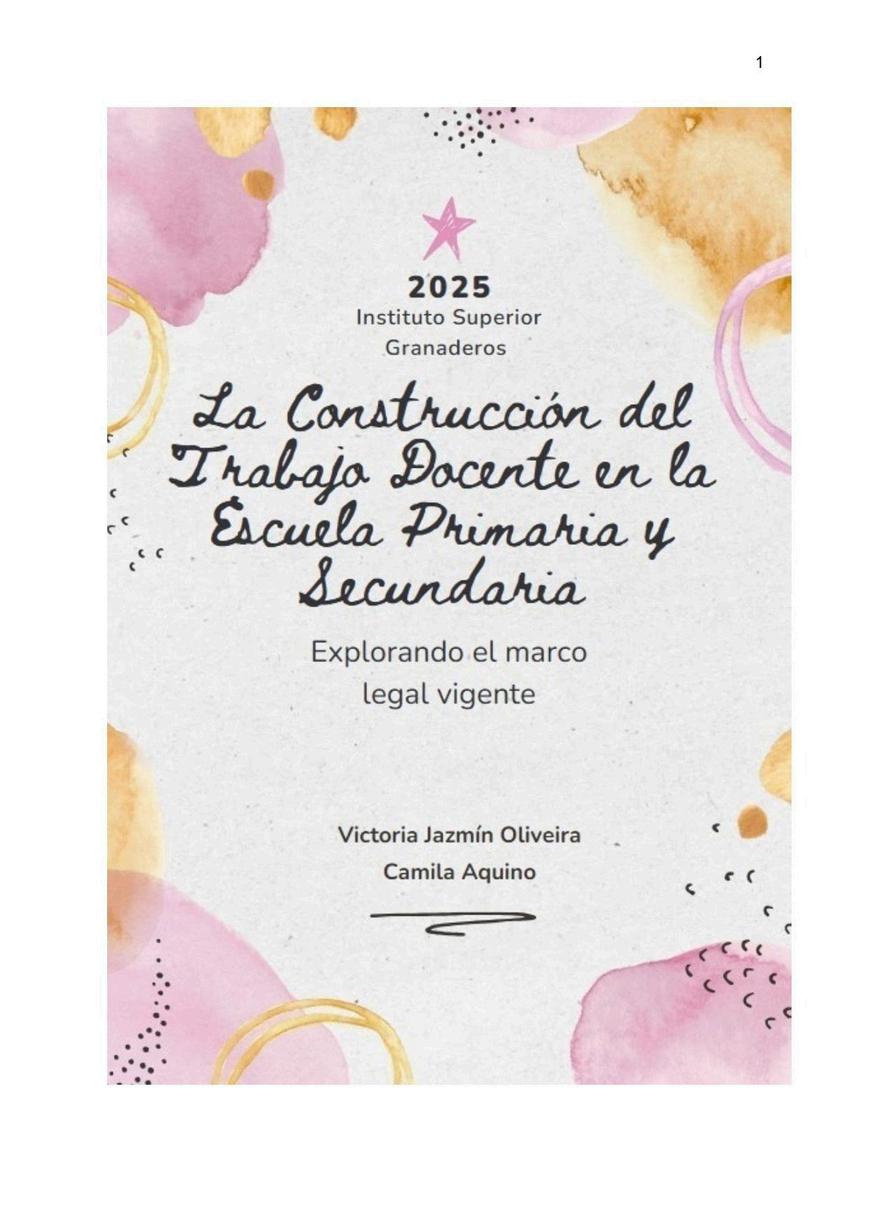





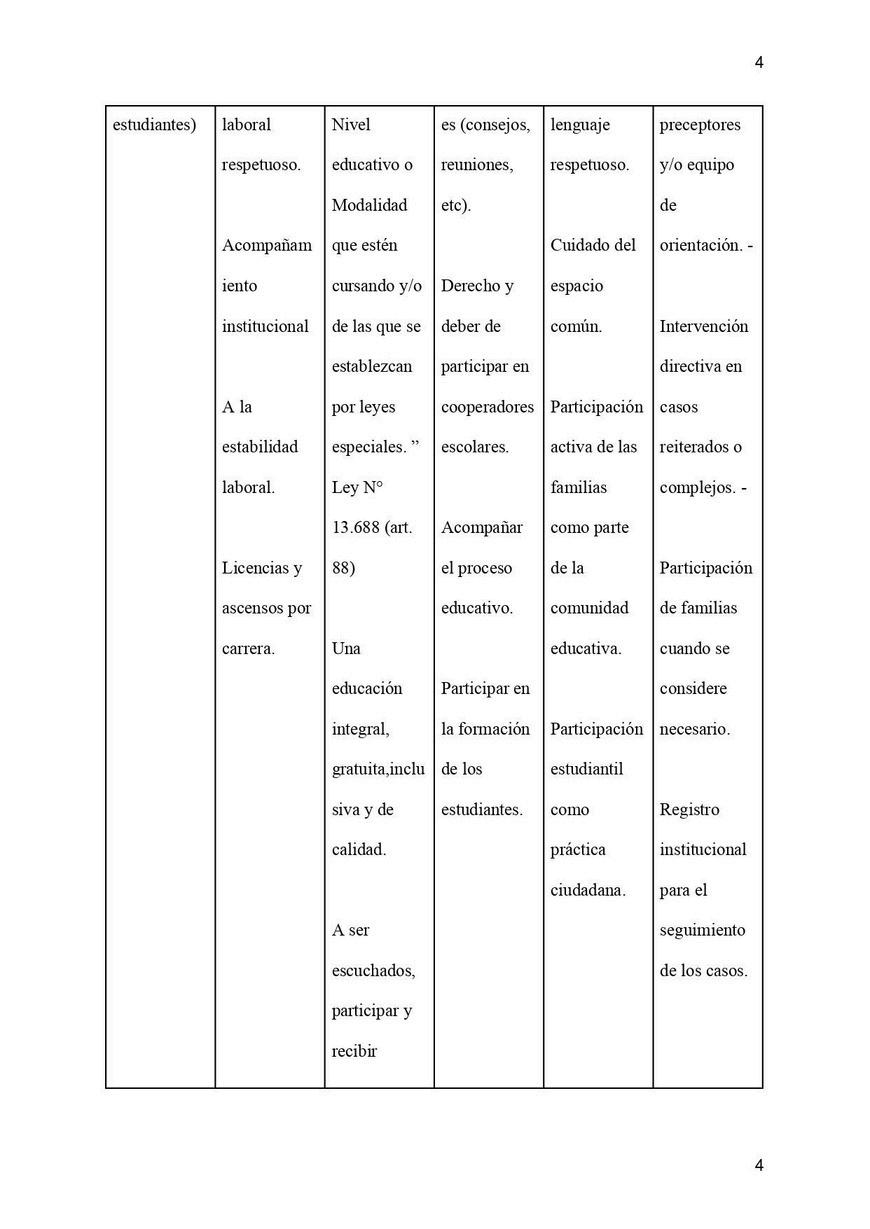











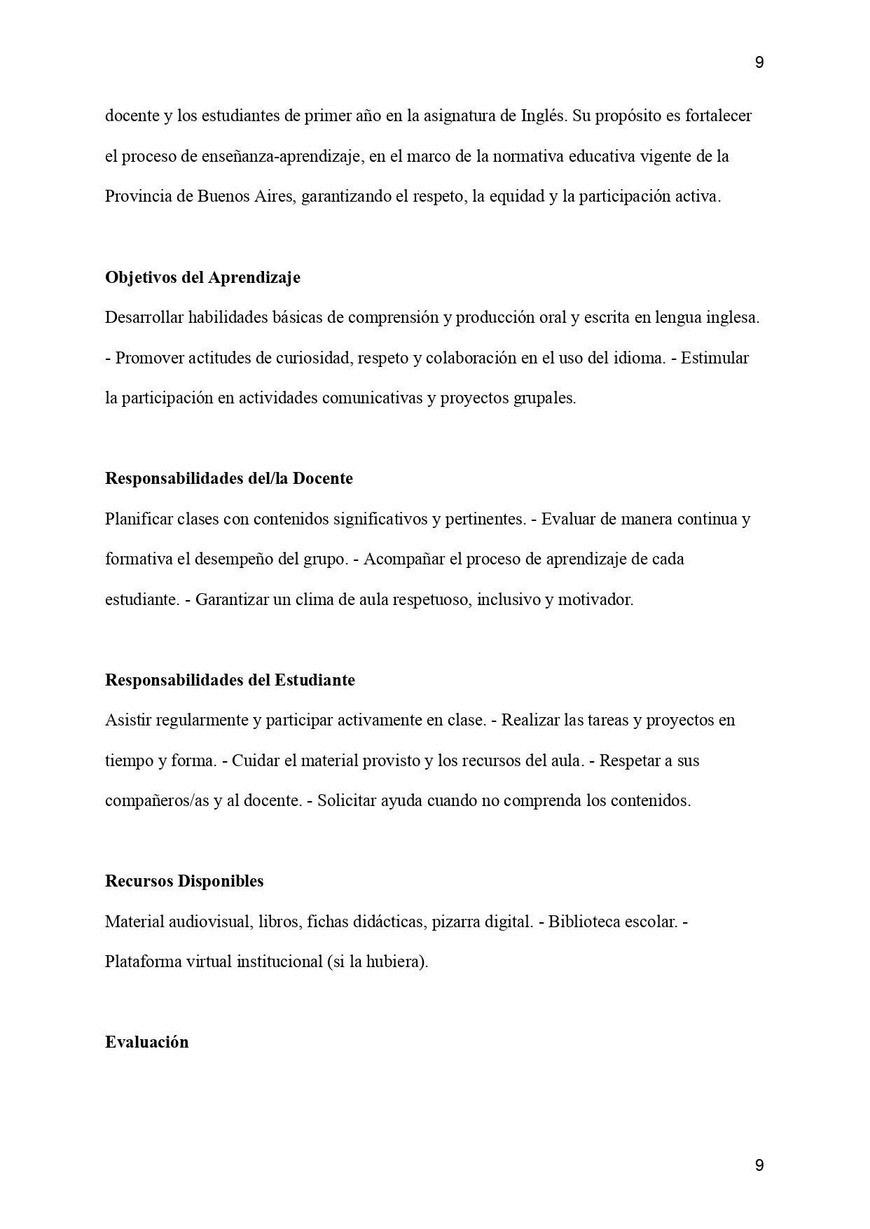




Grade
Graded on

Monday, May 12, 2025,4:22 PM
Graded by JV Juliana Viviani
Feedback comments:
● 80,00/100,00
Se nota un trabajocomprometido y con un esfuerzo sostenido en el análisis y producción. La entrega cubre con responsabilidad los tres desafíos: la matriz normativa, el acuerdo de convivencia y el contrato didáctico. Se identifican correctamente las normativas clave (Ley 26.206, Ley 13.688, Resoluciones 1724/11 y 1707/09), lo que demuestra un buen manejo de la legislación vigente. En el contrato didáctico, se observa una preocupación por generar condiciones equitativas y de respeto docente. para los y las estudiantes, con objetivos claros de aprendizaje y compromiso
●
Algunas sugerencias: Se valora positivamente la inclusión de todos los actores escolares, y la idea de revisión periódica. Sin embargo, faltan algunas precisiones sobre cómo se garantiza esa participación. Podrían ampliar cómo se organizarán concretamente esas instancias (por ejemplo, a través de encuestas, talleres, comisiones mixtas). Revisen el formato de la matriz para garantizar que cada categoría esté bien delimitada. Podrían usar una tabla con división de filas o encabezados claros por sección. Algunas categorías (como "aspectos de la convivencia escolar" o "procedimientos") merecen un desarrollo más profundo y articulado con ejemplos reales o situaciones escolares concretas.

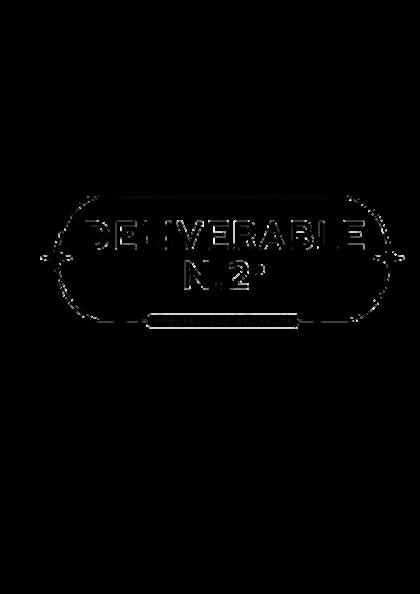










Grade
80,00/100,00
Graded on
Graded by

Monday, May 12, 2025,4:22 PM
JV Juliana Viviani
Feedback comments:
Debora, Barbara and Solana,
Youglow:
Youractivity is well thought-out, clearly inclusive, and demonstrates sensitivity to student diversity.
Tomlinson’s
The use of differentiated options and visual scaffolds aligns effectively with principles and creates an accessible task for all learners. Your justification in the conceptual section shows a deep understanding of key educational values like equity, empathy,and authentic learning.
Growth:
Tostrengthen your work even further:
Some phrases in the learning goal and procedure could be improved for accuracy and clarity. For example:“By the end of this activity, students will have learned and practiced new vocabulary…” is grammatically correct, but slightly ambiguous. Consider clarifying: “…students will be able to use at least five new vocabulary items in meaningful sentences related to weather and clothing. “This focus on learning and applying vocabulary will help…” – it would be more natural to say: “Focusing on learning and applying vocabulary will help…”
While conceptual you reference central authors like Tomlinson and Anijovich effectively in your section, the task-based activity itself could show stronger theoretical grounding For instance, you mention authentic tasks in the justification, but the activity (packing a suitcase) is only loosely connected to real-world use unless the students also simulate or roleplay a trip scenario Consider tightening the connection to TBLT theory (Ur, 2024; TBLT summary cited) by: Including a clear communicative outcome beyond vocabulary naming for example, a roleplay or mini-presentation at the end. Adding an evaluation step to support formative assessment, perhaps using a self-assessment checklist.
The learning goal is broad and lacks measurable indicators. Drawing from the Diseño Curricular and Ur (2024), you might rephrase the learning goal as: “Students will be able to select destination vocabulary related to clothing and weather and use it to describe their travel in at least three complete sentences.”
Wondering:
How might you adapt this task for students with very limited literacy skills or newcomers to English? How will you assess learning during and after the activity beyond observation? Could students self-evaluate or peer-assess their output?

















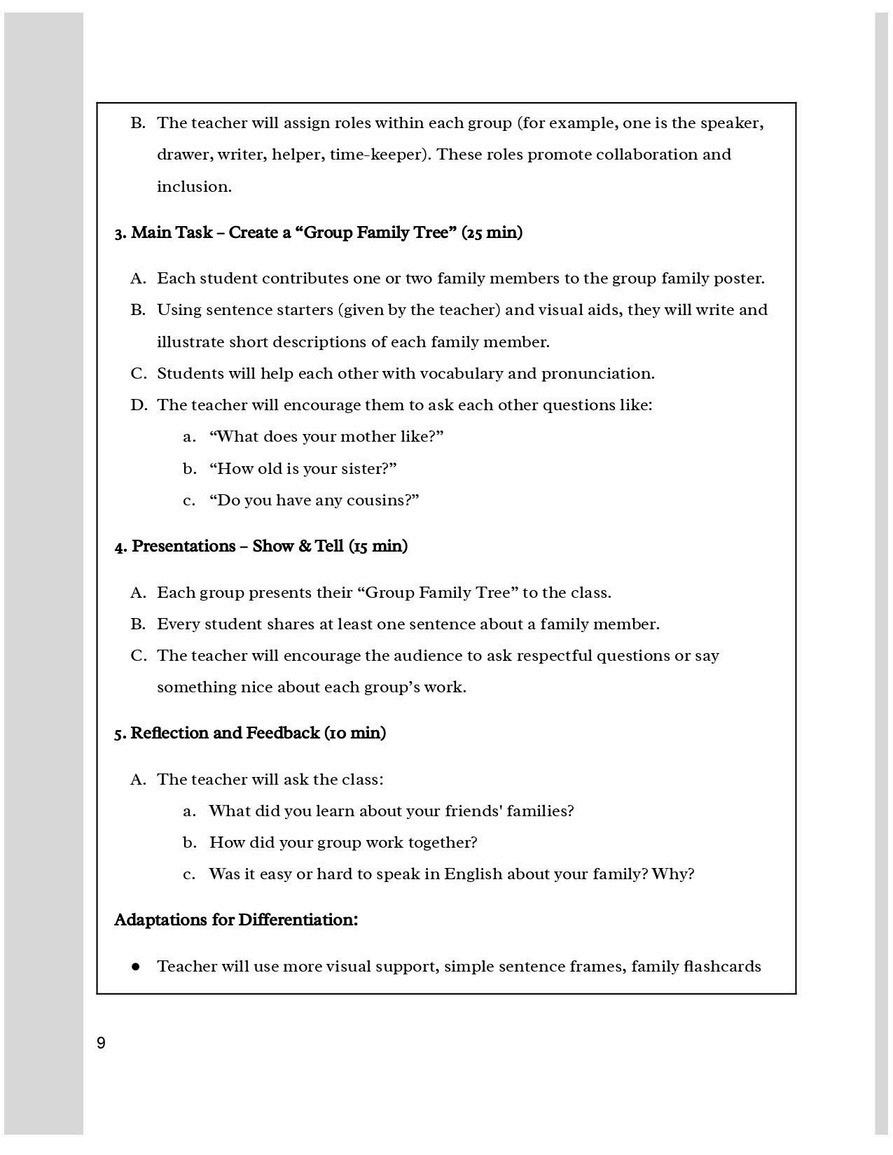



Feedback
Grade 85.00 / 100.00
Graded on Monday, 4 August 2025, 3:38 PM
Graded by JV Juliana Viviani
Feedback comments:
Yesica,
You Glow ✨
Your Justificación demonstrates a strong understanding of the theoretical underpinnings of powerful classrooms, making clear connections between curriculum design, inclusion, and the heterogeneity of the classroom. The “Family Tree Show & Tell” activity is inclusive, collaborative, and well-structured, encouraging respect for diverse family structures and promoting both linguistic and social skills. I especially like the integration of role distribution to ensure all students participate actively and the reflection stage that fosters empathy and active listening.
Growth ��
While the learning goals are specific, you could make them more measurable (e.g., “Each student will correctly produce at least three sentences about a family member”). The procedure is clear but could be slightly condensed for quicker reference during implementation. Including a simple evaluation checklist or rubric for vocabulary use, sentence accuracy, and participation would help monitor and assess learning outcomes.
Wondering ��
1. How might you adapt this activity for students who may have sensitive family situations or who prefer not to share personal details?
2. How could you integrate a short written follow-up, such as a mini family album page, to reinforce vocabulary and structures learned in the speaking task?














Grade 80.00 / 100.00
Graded on Monday, 4 August 2025, 3:11 PM
Graded by JV Juliana Viviani
Feedback comments: Camila and Victoria You Glow �� Your work shows a clear connection between theory and practice. The Justificación section is well written and reflects strong understanding of inclusive, democratic, and student-centered principles. The speaking activity is purposeful well-structured, and promotes both language skills and socio-emotional learning in an authentic way. The adaptations for inclusion are practical and sensitive to different student needs Growth ��
Some parts of the Justificación could be more concise to ensure the reader quickly grasps the key points. In the activity procedure, you might explicitly link each step to the stated learning goals, making it easier to track how objectives are met. Also, consider adding clear assessment criteria or success indicators so teachers know how to measure students progress in both language and SEL Wondering �� 1. How might you adapt this activity for larger classes where circle time could be challenging logistically?

2. How could you integrate a follow-up writing task to reinforce the vocabulary and structures learned during the speaking activity?



















Feedback
Grade 80.00 / 100.00
Graded on Tuesday, 23 September 2025, 2:30 PM
Graded by JV Juliana Viviani
Feedback comments: Solana, Yesi y Victoria,
¡Muy buen trabajo! Se nota el esfuerzo por estructurar un plan claro y coherente, con sustento teórico y un vínculo interesante con el contexto local.
Destaco:
La planificación está bien organizada y respeta la progresión de controlado → semi-controlado → libre, lo cual refleja una sólida comprensión del enfoque comunicativo.
La inclusión del contexto cercano (Ituzaingó) hace que las actividades sean significativas y relevantes para los estudiantes.
Diferenciación bien pensada: contemplan distintos estilos de aprendizaje y niveles de desempeño.
La combinación de evaluación formativa y sumativa muestra un buen equilibrio entre acompañamiento del proceso y verificación de logros.
El ensayo justifica las decisiones pedagógicas con autores reconocidos (Harmer, Cameron, Littlewood, Tomlinson, entre otros), lo cual enriquece la propuesta.
Sugerencias:
Revisar el tiempo destinado a cada actividad: quizá sea necesario prever pausas de repaso antes de pasar de semi-controlado a libre, especialmente para estudiantes con menor dominio.
La tarea de cierre escrita puede resultar un poco exigente después de tanta producción oral; podrían considerar una variante más breve o con apoyo visual para no saturar a los alumnos.
La diferenciación podría ampliarse con ejemplos concretos de cómo acompañar a quienes tengan dificultades sostenidas con la estructura (be + -ing).
En el ensayo, podrían vincular más directamente los fundamentos teóricos con ejemplos de su propia propuesta (por ejemplo, cómo Harmer respalda el uso del mime game).
Pregunta para seguir pensando...
¿Cómo podrían ajustar la secuencia para que los estudiantes con menor nivel de confianza en la oralidad tengan más oportunidades de practicar de manera gradual antes de pasar a las producciones libres?














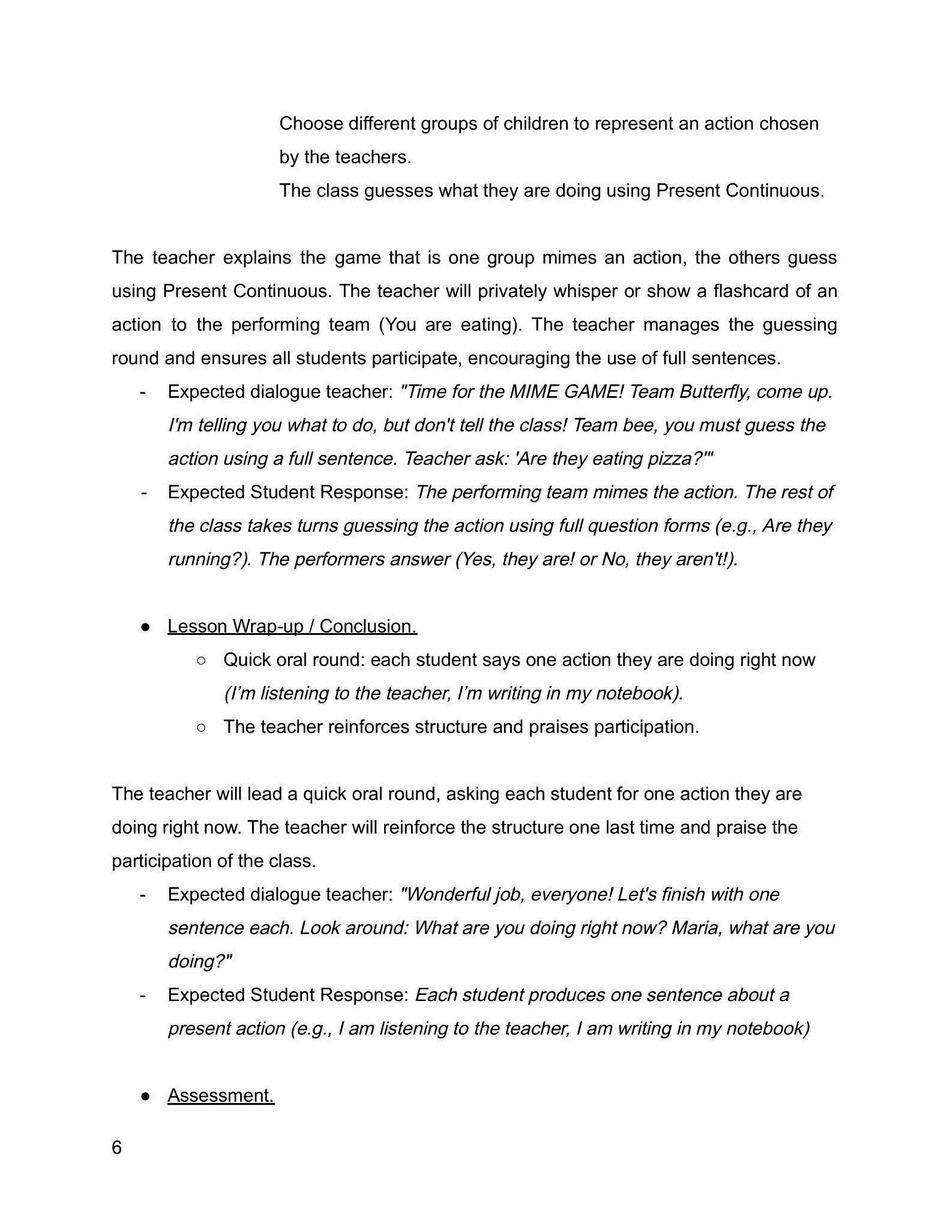













Grade 95.00 / 100.00
Graded on Tuesday, 28 October 2025, 8:34 AM
Graded by JV Juliana Viviani
Feedback comments
Yesi, Solana and Victoria,
I’ve been checking your Deliverable and I’m happy to tell you that you’ve done an amazing job designing your engaging and creative English lesson. It’s inspiring to see how much thought, effort, and passion you’ve put into your work.
I can’t wait to see you exploring, experimenting, and bringing your wonderful ideas into the classroom — the students will be lucky to have you!
Virtual hug,
Juliana







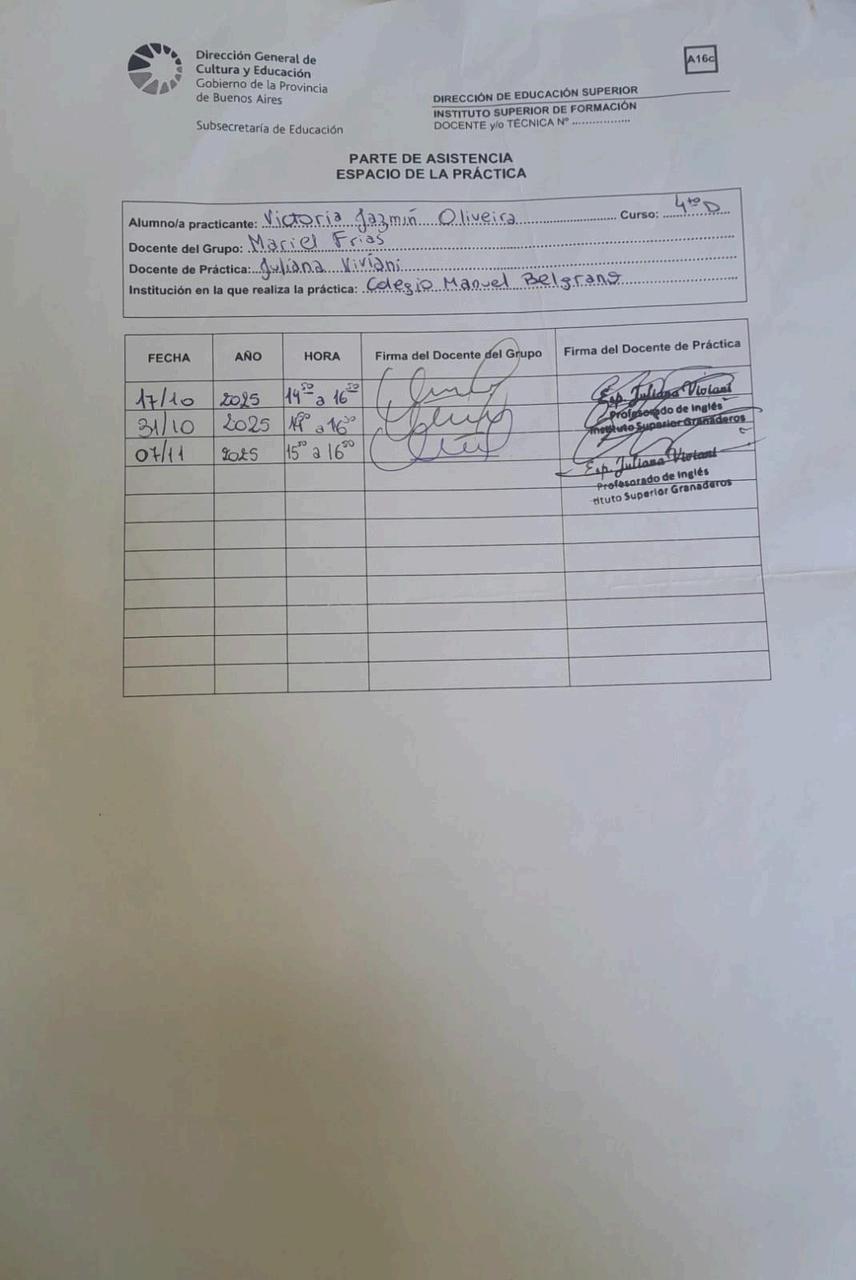



Introduction
This document is designed to assist future teachers during their class observation period. Observing experienced educators provides valuable insights into effective teaching practices and classroom management. The following sections outline the competencies needed for 21st-century teachers and provide a checklist for observations.
Competencies for 21st-Century Teachers
Critical Thinking and Problem Solving: Ability to analyze information and make informed decisions.
Creativity and Innovation: Encouraging creative thinking and new ideas in the classroom.
Collaboration: Working effectively with others, including students, parents, and colleagues.
Communication: Clear and effective communication skills for diverse audiences.
Digital Literacy: Proficiency in using technology for teaching and learning.
Flexibility and Adaptability: Ability to adjust teaching strategies in response to changing circumstances.
Social and Cultural Awareness: Understanding and respecting diverse backgrounds and perspectives.
Lifelong Learning: Commitment to continuous professional development and self-improvement.
Leadership: Guiding and inspiring students and colleagues.
Emotional Intelligence: Recognizing and managing emotions in oneself and others.
1 - Observation Chart
Course:4°D - Colegio General Manuel Belgrano
Topics: Name of course teacher: Mariel Frías
Name of observer: Solana, Bastonero
Date: October 17th 2025
# Item to Observe

3

Starting Time:
Classroom Environment: Is the classroom organized and conducive to learning?
Lesson Objectives: Are the objectives clear and communicated to the students?
Teaching Strategies: What instructional methods are being used?
Student Engagement: Are students actively participating in the lesson
Differentiation: How does the teacher address different learning styles and needs?
Use of Technology: Is technology integrated into the lesson? How is it used?
Feedback: How does the teacher provide feedback to students during the lesson?
Classroom Management: How does the teacher manage student behavior?
Assessment Techniques: What assessment methods are used during the lesson?
10 Collaboration: Are students working together? How does the teacher facilitate this?
11 Questioning Techniques: What types of questions does the teacher ask to stimulate thinking?
12 Cultural Responsiveness: How does the teacher incorporate diverse perspectives in the lesson?
13 Time Management: Is the lesson paced appropriately?
14 Adaptability: How does the teacher respond to unexpected challenges during the lesson?

15 Classroom Interaction: How does the teacher encourage interaction among students? Are there opportunities for peer-to-peer dialogue?
16 Closure: How does the teacher wrap up the Any lesson and reinforce learning? cliff-hangers?

Facts

Descriptive analysis of classroom observation
Feelings/ emotions/ interpretation
2 - Observation Chart
Course:4°D - Colegio General Manuel Belgrano
Topics:
Name of course teacher: Mariel Frías
Name of observer: Garcia Yesica
Date: October 17th 2025
# Item to Observe

3

Starting Time:
Classroom Environment: Is the classroom organized and conducive to learning?
Lesson Objectives: Are the objectives clear and communicated to the students?
Teaching Strategies: What instructional methods are being used?
Student Engagement: Are students actively participating in the lesson
Differentiation: How does the teacher address different learning styles and needs?
Use of Technology: Is technology integrated into the lesson? How is it used?
Feedback: How does the teacher provide feedback to students during the lesson?
Classroom Management: How does the teacher manage student behavior?
Assessment Techniques: What assessment methods are used during the lesson?
10 Collaboration: Are students working together? How does the teacher facilitate this?
11 Questioning Techniques: What types of questions does the teacher ask to stimulate thinking?
12 Cultural Responsiveness: How does the teacher incorporate diverse perspectives in the lesson?
13 Time Management: Is the lesson paced appropriately?
14 Adaptability: How does the teacher respond to unexpected challenges during the lesson?

15 Classroom Interaction: How does the teacher encourage interaction among students? Are there opportunities for peer-to-peer dialogue?
16 Closure: How does the teacher wrap up the Any lesson and reinforce learning? cliff-hangers?

Facts

Descriptive analysis of classroom observation
Feelings/ emotions/ interpretation
3 - Observation Chart
Course:4°D - Colegio General Manuel Belgrano
Topics:
Name of course teacher: Mariel Frías
Name of observer: Oliveira, Victoria
Date: October 17th 2025
# Item to Observe

3

Starting Time:
Classroom Environment: Is the classroom organized and conducive to learning?
Lesson Objectives: Are the objectives clear and communicated to the students?
Teaching Strategies: What instructional methods are being used?
Student Engagement: Are students actively participating in the lesson
Differentiation: How does the teacher address different learning styles and needs?
Use of Technology: Is technology integrated into the lesson? How is it used?
Feedback: How does the teacher provide feedback to students during the lesson?
Classroom Management: How does the teacher manage student behavior?
Assessment Techniques: What assessment methods are used during the lesson?
10 Collaboration: Are students working together? How does the teacher facilitate this?
11 Questioning Techniques: What types of questions does the teacher ask to stimulate thinking?
12 Cultural Responsiveness: How does the teacher incorporate diverse perspectives in the lesson?
13 Time Management: Is the lesson paced appropriately?
14 Adaptability: How does the teacher respond to unexpected challenges during the lesson?

15 Classroom Interaction: How does the teacher encourage interaction among students? Are there opportunities for peer-to-peer dialogue?
16 Closure: How does the teacher wrap up the Any lesson and reinforce learning? cliff-hangers?

Facts

Descriptive analysis of classroom observation
Feelings/ emotions/ interpretation


● General Information.
○ School’s name: Colegio Manuel Belgrano. ○ Address:
General de Alvear 1075, Ituzaingó - Bs. As ○ Course
Title: English ○ Grade Level: 4th Grade ○ Shift: D ○
Date: 7th November ○ Duration: 60 minutes
● Topic.
○ Doing activities while you are in Ituzaingó
● Didactic Sequence.
○ Lesson Objectives:
■ Students will be able to identify and use the Present Continuous to describe actions happening at that moment near their school.
○ Language Objectives:
■ Students will produce sentences using: Subject + be + verb + -ing
walking in the park)

(I am
■ Students will ask and answer simple questions in Present Continuous (What are you doing? – I’m eating an ice cream).
● Lesson Stages.
○ Lesson Warm-up / Introduction (Hook):
■ Time: 10 minutes
■ Objective: introduce the target structure in a meaningful and familiar context.
● Lesson Development.
○ Activity 1 (Controlled practice):
■ Students complete short sentences with the correct form of the verb to be + verb + ing (She playing in the plaza).
○ Activity 2 (Semi-controlled practice):
■ In pairs, students receive pictures of places in Ituzaingó (square, train station, park) and describe what people are doing.
● Differenciations:
The teacher provides sentence starters: “He is ___ing.” “They are ___ing.” Visual support with flashcards of verbs (walk, listen, take a photo,etc).

Transition Activity:
The teacher will divide the class into two teams. Each student takes a sticker (Team Butterfly �� / Team Bee ��) from a bag to know their team. The teacher explains the challenge.
● Differenciations:
Students can use the visual aids from Activity 2 or copy a model from the board. The teacher encourages all to read at least one sentence aloud for confidence building.
○ Activity 3 (Free practice):
■ MIME GAME: Guess what your classmates are doing.
● Lesson Wrap-up / Conclusion.
○ Quick oral round: each student says one action theyare doing right now (I’m
○ The teacher reinforces structure and praises participation.
● Assessment.
○ Formative Assessment:
■ Teacher monitors pair and group activities, noting correct use of Present Continuous.
○ Summative Assessment:
■ Exit Ticket: Students complete a short, matching task where they link an image of an action to the correct Present Continuous sentence (Match with the sentence: He is running).
● Materials and Resources.
○ Textbooks / Materials:
■ Pictures of local places in Ituzaingó, flashcards of actions, worksheets for Activity 1, stickers for team division, Exit Ticket sheets.
○ Technology:
■ Optional projector/slides with images of Ituzaingó.
● Differentiation.
○ Visual learners: Use pictures of actions and places. Provide a visual chart on the board showing Subject + be + Verb-ing listening to the teacher, I’m writing in my notebook).

○ Auditory learners: Listen and repeat Present Continuous sentences. The teacher over-enunciates the be verb and the -ing ending ("She is eating an ice cream").
○ Kinesthetic learners: Miming actions. Allow students to physically point to themselves or a classmate when saying "I am..." or "He is...".
○ Students at risk: Sentence frames provided (I am ___ing at the ___).The teacher sits with this group during Activity 2 and uses a fill-in-the-blank approach for their oral responses: "He is...?" (Student: "running").
○ Advanced students: Write a short paragraph (5 sentences) describing what their family members or pets are doing at home right now Encourage them to use adverbs of time (currently, at the moment).
● Reflective Practice.
○ Strengths:
■ Engaging local context makes the language meaningful; the sequence respects the controlled → semi-controlled → free progression, supported by a team game as a confidence-building bridge.
○ Areas for Improvement:
■ Allow more time for students with lower proficiency to practice orally before writing.
■ Transition Activity is quick and focused to maintain momentum. Allow students with lower proficiency more teacher-guided oral practice before thefree-practice MIME GAME to build confidence.


La escalera de la retroalimentación
“La Escalera de la Retroalimentación es una herramienta que ayuda a cultivar una cultura de la valoración. Es una guía que puede ayudar a otros a apoyar la indagación en el aprendizaje, estableciendo una cultura de confianza y apoyo constructivo ” (Heidi Goodrich)
Feedback Ladder Protocol, Daniel Wilson (1999)


Explicación de cada peldaño
I. Clarificación Cuando se comparte un trabajo, éste parecer poco claro o alguna información se pudo haber omitido. Es esencial hacer preguntas acerca de los aspectos que son poco claros o ideas que no están presentes antes de dar la retroalimentación.
II. Valoramos Enfatizar los puntos positivos del trabajo, destacar las fortalezas y ofrecer cumplidos honestos, genera un tono de apoyo durante una sesión de retroalimentación. Este tipo de valoración honra a las personas y a sus ideas más importantes.
III. Nos preocupa, nos inquieta, nos preguntamos Con frecuencia hay inquietudes legítimas acerca del trabajo que se está valorando Quizás usted encuentra problemas o no está de acuerdo con las ideas o acciones en cuestión. Este peldaño permite expresar dichas inquietudes, no como acusaciones o críticas negativas, sino como pensamientos e inquietudes honestos.
IV.Sugerir: Ofrecer sugerencias para resolver los problemas que hemos identificado puede ayudar a los colegas a utilizar la retroalimentación.






















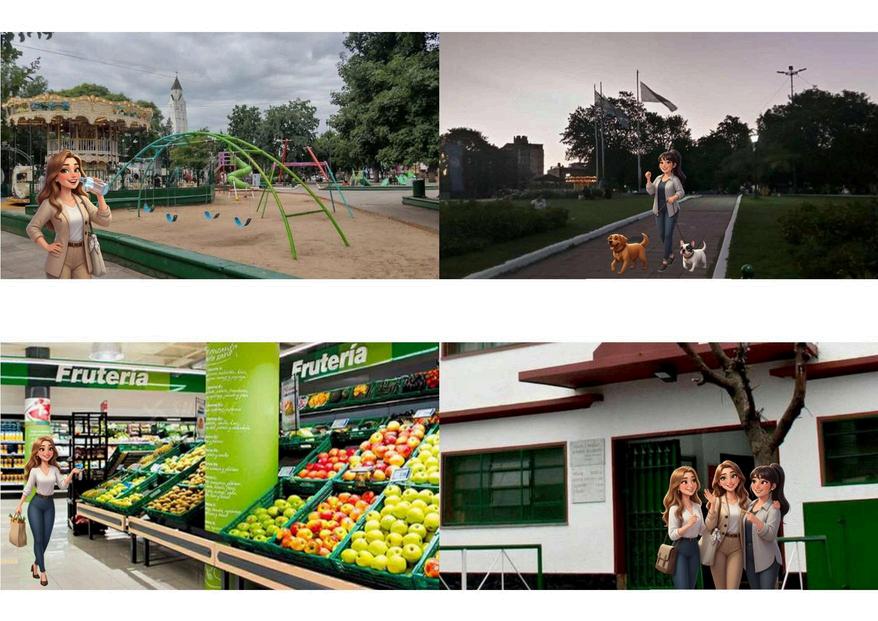
● Worksheet- Activity 1 (Controlled practice):

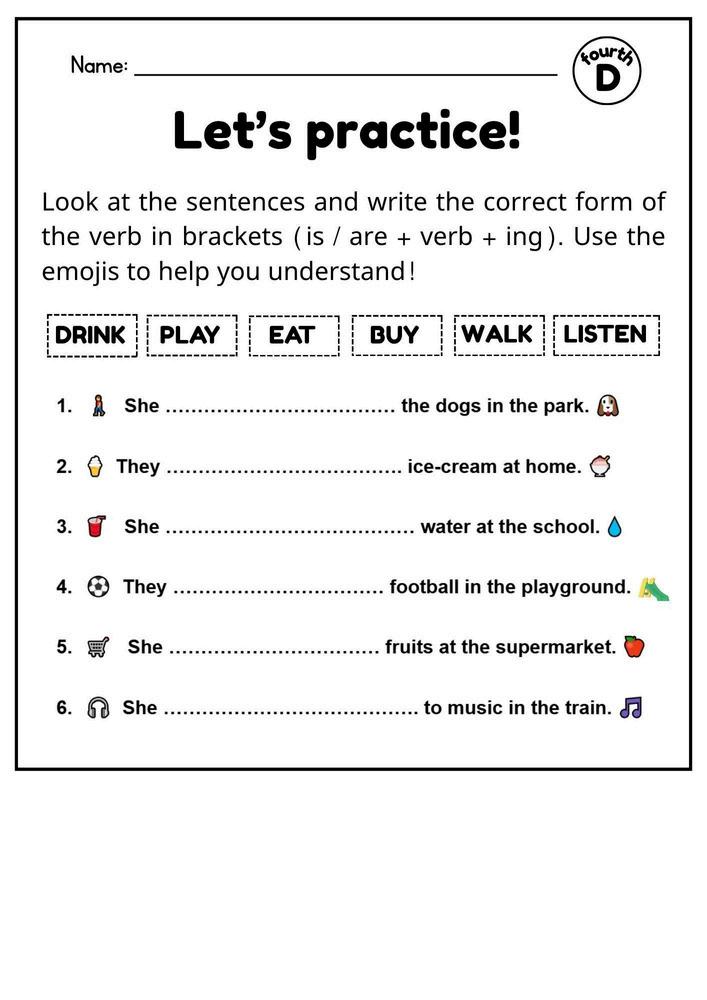





● TransitionActivity:
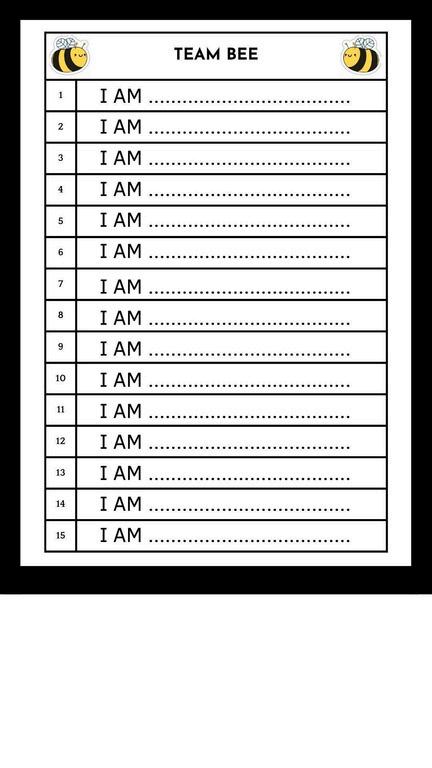


●
● Exit ticket Decidiendo materiales:
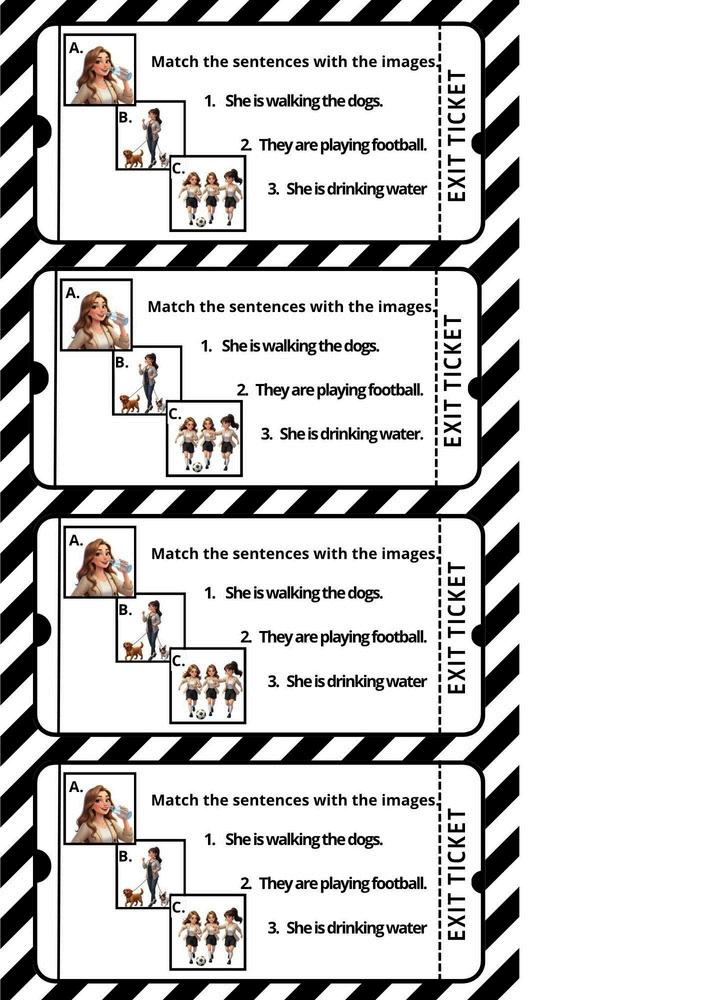




● Segunda clase de observación. Las actividades que llevo la profesora alusivas a Halloween.


● Experimentando con la IA “Nano banana”


● Materiales recolectados de los alumnos:


● Foto terminada la práctica:
